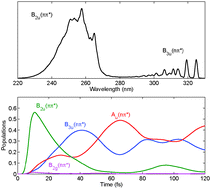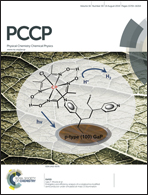The role of the low-lying dark nπ* states in the photophysics of pyrazine: a quantum dynamics study
Abstract
The excited state dynamics of pyrazine has attracted considerable attention in the last three decades. It has long been recognized that after UV excitation, the dynamics of the molecule is impacted by strong non-adiabatic effects due to the existence of a conical intersection between the B2u(ππ*) and B3u(nπ*) electronic states. However, a recent study based on trajectory surface hopping dynamics simulations suggested the participation of the Au(nπ*) and B2g(nπ*) low-lying dark electronic states in the ultrafast radiationless decay of the molecule after excitation to the B2u(ππ*) state. The purpose of this work was to pursue the investigation of the role of the Au(nπ*) and B2g(nπ*) states in the photophysics of pyrazine. A linear vibronic coupling model hamiltonian including the four lowest excited electronic states and the sixteen most relevant vibrational degrees of freedom was constructed using high level XMCQDPT2 electronic structure calculations. Wavepacket propagations using the MCTDH method were then performed and used to simulate the absorption spectrum and the electronic state population dynamics of the system. Our results show that the Au(nπ*) state plays an important role in the photophysics of pyrazine.


 Please wait while we load your content...
Please wait while we load your content...